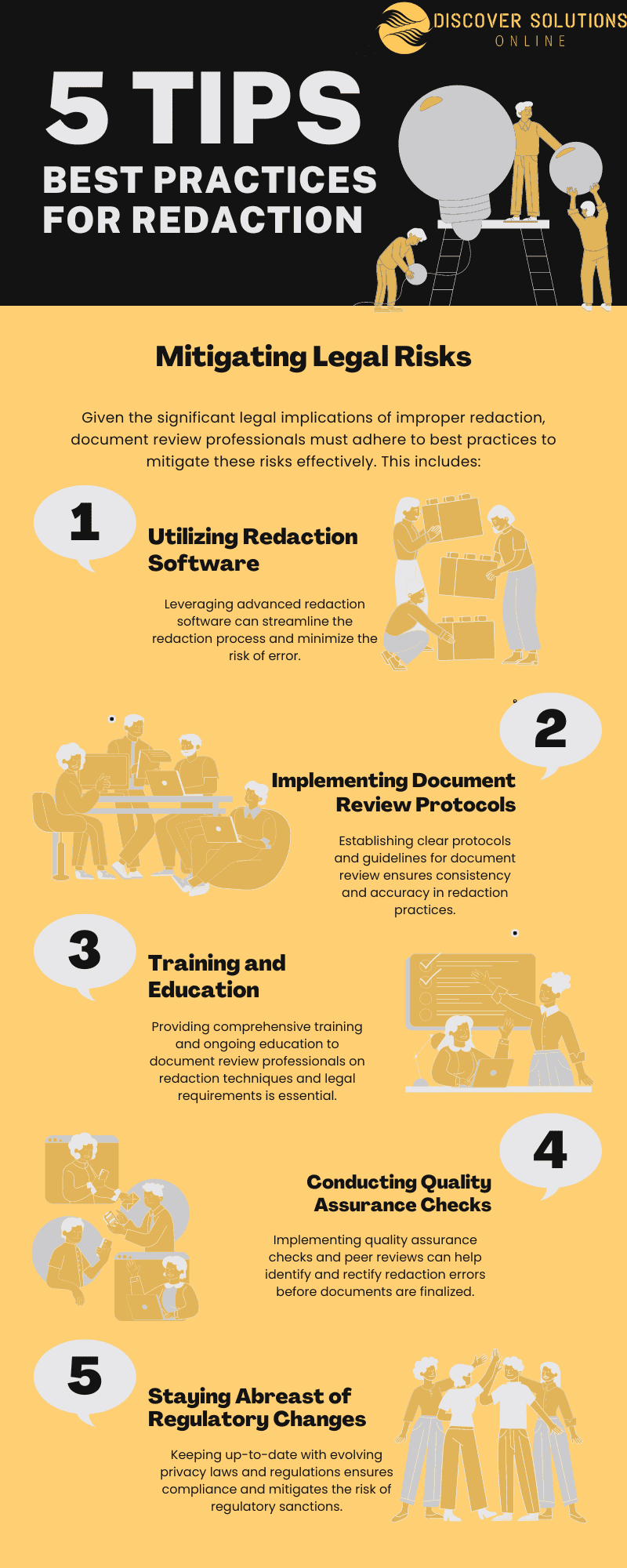In the realm of legal document review, redaction stands as a pivotal process ensuring confidentiality and compliance. Document review professionals shoulder the responsibility of meticulously scrutinizing documents to identify sensitive information and subsequently redact it. However, despite the utmost care, errors can occur, leading to severe repercussions. Understanding the common mistakes in redaction and their consequences is imperative for professionals navigating legal risks. Here, we delve into some prevalent blunders and their potential aftermaths.
Common Mistakes in Redaction and Their Consequences
Redaction, the process of obscuring sensitive information in documents, plays a crucial role in legal and compliance practices. It ensures confidentiality while promoting transparency. However, even minor redaction mistakes can have serious consequences. This section explores common redaction pitfalls and their potential impact, helping document review professionals navigate legal risks effectively.
Incomplete Redaction
Incomplete redaction is one of the most common and consequential errors encountered in document review. It transpires when only a portion of sensitive information gets redacted, leaving remnants of confidential data exposed. Such oversights can occur due to oversight or inadequate review processes. The consequence of incomplete redaction is dire, as it compromises confidentiality, potentially leading to data breaches, legal ramifications, and reputational damage for both clients and firms.
Consider a scenario where a law firm is preparing documents for a high-stakes litigation case. Despite diligent efforts, the legal team inadvertently overlooks redacting certain financial figures in a contract. Subsequently, during court proceedings, the opposing counsel exploits this oversight, arguing that the disclosed figures contain proprietary information critical to their case. As a result, the court rules against the firm, imposing sanctions for failing to protect confidential information adequately.
Failure to Verify Redactions
Another prevalent mistake is the failure to verify redactions post-implementation. This oversight arises when document reviewers neglect to confirm that redacted information is indeed rendered inaccessible. Without verification, erroneous redactions may go unnoticed, leaving sensitive data vulnerable to exposure. Consequently, legal repercussions may ensue, accompanied by loss of trust from clients and stakeholders.
In a corporate merger scenario, a legal team prepares confidential documents for regulatory review, redacting sensitive financial projections to comply with securities laws. However, due to the absence of a verification process, certain redactions are incomplete, allowing unauthorized access to proprietary information. As a result, regulatory authorities launch an investigation into the breach, imposing hefty fines on the company for non-compliance and negligence in redaction practices.
Inconsistent Redaction Methods
Inconsistency in redaction methods poses a significant challenge in document review. It occurs when reviewers employ varied techniques or standards across documents, resulting in discrepancies in the treatment of sensitive information. Such disparities undermine the uniformity and reliability of redacted documents, potentially complicating legal proceedings and impeding regulatory compliance efforts.
Imagine a legal team tasked with redacting privileged communication in a collection of emails related to a corporate lawsuit. While some reviewers opt for a conservative approach, redacting any potentially sensitive content, others adopt a more lenient stance, omitting certain passages deemed non-essential. Consequently, inconsistencies arise in the redacted documents, raising concerns about the accuracy and completeness of the redaction process, thereby jeopardizing the legal strategy and complicating the litigation.
Inadequate Training and Oversight
Insufficient training and oversight exacerbate the risk of redaction errors among document review professionals. Without comprehensive training programs and effective supervision, reviewers may lack the necessary skills and knowledge to perform redactions accurately. This deficiency increases the likelihood of mistakes, exposing organizations to legal liabilities and diminished credibility.
Consider a scenario where a legal services firm experiences a surge in document review projects but fails to provide adequate training to new hires due to time constraints. Consequently, inexperienced reviewers struggle to identify and redact sensitive information effectively, resulting in errors and inconsistencies across documents. The lack of oversight exacerbates the situation, as errors go undetected until clients raise concerns about confidentiality breaches, tarnishing the firm’s reputation and prompting legal repercussions.
Over-Redaction
Over-Redaction, characterized by excessive or unnecessary redactions, presents a significant pitfall in document review. This error often stems from an overly cautious approach or a lack of clarity regarding what constitutes sensitive information. Over-redaction not only obstructs document comprehension but also raises suspicions regarding transparency and compliance. Moreover, it may lead to challenges during litigation, with adversaries questioning the legitimacy of redactions and potentially obtaining court orders for disclosure.
In a regulatory investigation, a company’s legal team is tasked with redacting privileged communication from a vast collection of documents to comply with discovery requests. In their zeal to protect sensitive information, the reviewers adopt an overly aggressive redaction strategy, obscuring entire pages of text indiscriminately. As a result, key details relevant to the investigation are obscured, impeding the regulatory process and triggering sanctions for obstructing justice.
Failure to Update Redactions
Failure to update redactions in response to evolving circumstances or legal requirements can have detrimental consequences. As laws and regulations change, previously redacted information may become subject to disclosure or modification. Neglecting to revise redactions accordingly may result in non-compliance, legal penalties, and erosion of client trust.
In a merger and acquisition transaction, a law firm redacts sensitive financial information from disclosure documents to comply with confidentiality agreements. However, midway through the transaction, regulatory authorities issue new guidelines requiring additional disclosures. Despite the regulatory update, the legal team fails to revisit the redacted documents, leaving them outdated and non-compliant. Consequently, the transaction is delayed, and the firm faces legal scrutiny for failing to adhere to regulatory requirements.
Inadequate Quality Control Measures
Inadequate quality control measures contribute to redaction errors by allowing inaccuracies to go undetected. Without robust quality assurance protocols, such as peer reviews or random audits, mistakes in redaction may persist, jeopardizing the integrity of the entire document review process. Moreover, the absence of effective controls heightens the risk of data breaches and regulatory violations.
Imagine a legal department tasked with redacting sensitive information from a large volume of documents for litigation discovery. Due to resource constraints, the department foregoes quality control measures, relying solely on individual reviewers to identify and redact sensitive information. Consequently, errors and inconsistencies proliferate throughout the redaction process, undermining the credibility of the documents and exposing the organization to legal liabilities and reputational damage.
Technical Challenges and Tools Limitations
Technical challenges and limitations of redaction tools can impede the efficacy of the redaction process. Issues such as software glitches, compatibility issues, or inadequate functionalities may hinder reviewers’ ability to perform accurate redactions efficiently. Consequently, document review professionals must remain vigilant and adapt alternative strategies to mitigate these technical hurdles and uphold data security standards.
Consider a scenario where a legal team utilizes redaction software to automate the redaction process for a large volume of documents. However, midway through the project, the software encounters compatibility issues with certain file formats, rendering it ineffective for redacting critical information. As a result, the review process is delayed, and the team is forced to resort to manual redaction, significantly increasing the risk of errors and inefficiencies.
Ignoring Metadata Redaction
Metadata, often overlooked during the redaction process, contains valuable information about a document’s history, including authorship, revisions, and timestamps. Failure to redact metadata can inadvertently disclose sensitive details, such as the identities of individuals involved or privileged communication dates. This oversight can lead to breaches of confidentiality and compromise legal strategies. For example, in a high-profile case, unredacted metadata revealed confidential discussions between attorneys and clients, resulting in significant repercussions for the legal team and their client.
Lack of Communication and Collaboration
Effective communication and collaboration among document review teams are essential for ensuring consistency and accuracy in redaction efforts. When teams operate in silos or fail to communicate effectively, inconsistencies in redaction standards and methodologies may arise, increasing the risk of errors. Encouraging open dialogue and establishing clear communication channels can mitigate these risks, fostering a collaborative environment conducive to effective redaction practices.
In a complex litigation case, multiple legal teams are responsible for reviewing and redacting documents from various sources. However, due to fragmented communication channels and lack of collaboration, inconsistencies emerge in the redaction process, leading to confusion and delays. By implementing a centralized communication platform and facilitating cross-team collaboration, the organization can streamline the redaction process, minimize errors, and enhance overall efficiency.
Underestimating the Importance of Context
Redaction decisions must be informed by a thorough understanding of the document’s context and relevance to the legal matter at hand. Failing to consider contextual factors such as the purpose of the document, the identity of involved parties, and the nature of the legal dispute can result in inappropriate redactions or omissions. For example, redacting information that is critical to understanding a contract’s terms or contractual obligations could hinder legal proceedings and undermine the document’s integrity.
In a contract dispute between two companies, a legal team is tasked with redacting financial terms from a series of agreements. Without considering the context of the contracts and the specific clauses under scrutiny, the team indiscriminately redacts all financial figures, including those essential to understanding payment terms and obligations. Consequently, the opposing party challenges the redactions, alleging obstruction of evidence and delaying the resolution of the dispute
Non-Compliance with Data Privacy Regulations
In an era of stringent data privacy regulations, such as the General Data Protection Regulation (GDPR) and the California Consumer Privacy Act (CCPA), non-compliance with redaction requirements can have severe legal and financial consequences. Failure to redact personally identifiable information (PII) or protected health information (PHI) in accordance with applicable regulations can lead to regulatory fines, legal sanctions, and reputational damage. Document review professionals must stay abreast of evolving privacy laws and incorporate compliance measures into their redaction processes to mitigate these risks effectively.
Imagine a healthcare provider’s legal team tasked with redacting patient records for a medical malpractice lawsuit. Despite strict regulations governing the disclosure of patient information, the team overlooks certain PHI elements during the redaction process. As a result, confidential patient data is inadvertently disclosed during court proceedings, triggering a regulatory investigation and substantial fines for violating patient privacy rights.
Relying Solely on Automated Redaction Tools
While automated redaction tools offer efficiency and convenience, relying solely on technology without human oversight can result in errors and inaccuracies. Automated tools may overlook nuanced contextual cues or fail to recognize sensitive information in unconventional formats, leading to incomplete or inaccurate redactions. Document review professionals should complement automated tools with manual review processes to ensure thoroughness and accuracy in redaction efforts.
In a large-scale document review project, a legal team employs automated redaction software to expedite the process. However, due to the complexity of the documents and the variability of redaction requirements, the software fails to accurately identify and redact certain sensitive information, such as privileged communication or confidential financial data. Consequently, the team must allocate additional resources to manually review and correct the errors, delaying the project and increasing costs.
Ignoring Ethical Considerations
Ethical considerations play a crucial role in the redaction process, particularly concerning privileged communication and attorney-client confidentiality. Failing to uphold ethical standards, such as preserving the confidentiality of privileged information or respecting legal privileges, can have profound ethical and professional ramifications. Document review professionals must adhere to ethical guidelines and consult with legal counsel when encountering sensitive ethical dilemmas during the redaction process.
In a criminal defense case, a legal team is tasked with redacting privileged communication between the defendant and their attorney. Despite clear instructions to preserve attorney-client confidentiality, a junior associate inadvertently includes privileged emails in the redacted documents submitted to the court. As a result, the defendant’s legal defense strategy is compromised, and the legal team faces disciplinary action for breaching ethical obligations to their client.
Inadequate Response to Redaction Challenges
Document review professionals may encounter unexpected challenges or disputes regarding redaction decisions during legal proceedings. Inadequate preparation or response to these challenges can undermine the credibility of redaction efforts and prolong litigation. Implementing robust protocols for addressing redaction challenges, such as documenting decision-making rationale and seeking judicial guidance when necessary, can bolster the defensibility of redaction decisions and streamline the resolution of disputes.
In a contentious intellectual property dispute, a legal team faces challenges regarding the redaction of trade secrets and proprietary information from technical documents. Despite extensive efforts to redact sensitive information, the opposing party disputes the adequacy of the redactions, alleging that critical details are still accessible. In response, the legal team proactively engages with the court to address the concerns, providing additional evidence and explanations to support the redaction decisions. As a result, the court validates the redactions, preserving the confidentiality of sensitive information and expediting the resolution of the dispute.
By addressing these additional points and providing comprehensive insights into common redaction mistakes and their consequences, document review professionals can enhance their proficiency and mitigate legal risks effectively. Through continuous training, collaboration, and adherence to best practices, organizations can fortify their redaction processes and safeguard sensitive information with confidence.

Legal Implications of Improper Redaction
In the field of document review, safeguarding confidentiality and ensuring the protection of sensitive information are paramount tasks. Despite the advancements in technology and established protocols, the risks associated with improper redaction persist. In this comprehensive guide, we will delve deep into the legal ramifications of flawed redaction practices, shedding light on the potential pitfalls that document review professionals must navigate with utmost diligence.
Introduction to Document Redaction and Its Importance
Document redaction is the process of editing or obscuring sensitive information within documents to prevent unauthorized access or disclosure. It is a crucial aspect of document review, particularly in legal, regulatory, and corporate environments where confidentiality is paramount. Redaction ensures that only relevant information is disclosed while sensitive or privileged content remains protected.
Breach of Confidentiality
One of the most significant legal implications of improper redaction is the breach of confidentiality. When sensitive information is inadequately redacted or left exposed, it can lead to unauthorized access and disclosure of confidential data. This breach not only undermines client trust but also exposes organizations to legal liabilities, including lawsuits and regulatory penalties.
Violation of Privacy Laws
In today’s regulatory landscape, numerous laws and regulations govern the protection of personal data and sensitive information. Improper redaction can lead to violations of privacy laws such as the General Data Protection Regulation (GDPR) in the European Union or the Health Insurance Portability and Accountability Act (HIPAA) in the United States. Non-compliance with these regulations can result in severe consequences, including hefty fines and reputational damage.
Exposure of Trade Secrets and Intellectual Property
Inadequate redaction poses a significant risk to trade secrets and intellectual property. When proprietary information is not properly safeguarded, it can be exposed to competitors, leading to unfair competition and financial losses. Document review professionals must exercise diligence in redacting trade secrets and confidential business strategies to mitigate this risk effectively.
Compromised Litigation Strategy
In legal proceedings, strategic advantage often hinges on the protection of sensitive information. Improper redaction can inadvertently disclose litigation strategies, witness identities, or other confidential materials, jeopardizing the client’s case. This can result in compromised outcomes, legal setbacks, and erosion of client confidence in legal counsel.
Damage to Reputation and Trust
Beyond legal repercussions, the fallout from improper redaction can inflict lasting damage to an organization’s reputation and trustworthiness. Clients expect their legal representatives to uphold the highest standards of confidentiality and professionalism. Any breach in this regard can lead to reputational harm, loss of clients, and diminished market credibility.
Regulatory Sanctions and Penalties
Regulatory bodies impose stringent penalties for data breaches and privacy violations, with fines escalating based on the severity of the infraction. In cases where improper redaction leads to non-compliance with data protection laws, organizations may face regulatory sanctions, audits, and mandatory remediation measures. These penalties can have far-reaching financial implications and tarnish the organization’s standing in the industry.
Legal Malpractice Claims
In extreme cases of negligence or incompetence, improper redaction can expose legal professionals to malpractice claims. Clients who suffer harm as a result of inadequate redaction may pursue legal recourse against their attorneys for professional negligence. Legal malpractice claims not only entail financial liabilities but also inflict reputational damage on individual practitioners and their firms.
Loss of Competitive Advantage
In competitive industries, safeguarding sensitive information is crucial to maintaining a competitive edge. Improper redaction can erode this advantage by inadvertently disclosing proprietary data, market strategies, or innovative technologies to rivals. The loss of confidential information can empower competitors, undermine market position, and impede business growth.
Strategies for Minimizing Risks During the Redaction Process
In the intricate world of document review, where legal risks loom large, the redaction process stands as a crucial barrier between sensitive information and unintended exposure. Document review professionals shoulder the responsibility of safeguarding confidential data, ensuring compliance with legal regulations, and mitigating risks associated with inadvertent disclosures. However, navigating through the redaction process poses its own set of challenges, ranging from technological limitations to human errors. In this guide, we delve into effective strategies aimed at minimizing risks during the redaction process, empowering document review professionals to navigate this critical phase with confidence and precision.
Understanding the Scope and Sensitivity of Information
Before embarking on the redaction journey, it is imperative for document review professionals to gain a comprehensive understanding of the scope and sensitivity of the information contained within the documents. Conducting a thorough review and classification of documents based on their level of confidentiality and relevance to the case at hand lays the foundation for an effective redaction strategy. By prioritizing the identification of sensitive information such as personally identifiable information (PII), privileged communications, and trade secrets, professionals can streamline the redaction process and allocate resources efficiently.
Implementing Robust Redaction Protocols
Establishing robust redaction protocols is essential for ensuring consistency, compliance, and accountability throughout the document review process. Document review professionals should develop standardized procedures and guidelines encompassing redaction criteria, approval workflows, and quality assurance measures. By instituting clear protocols for identifying, reviewing, and validating redacted content, teams can mitigate the risk of oversight and discrepancies. Moreover, conducting regular training sessions and knowledge-sharing initiatives empowers professionals to stay abreast of evolving redaction techniques and best practices, fostering a culture of continuous improvement within the organization.
Conducting Thorough Quality Assurance Checks
Quality assurance serves as a critical checkpoint in the redaction process, enabling document review professionals to validate the accuracy and completeness of redacted documents before finalization. Implementing rigorous quality assurance checks involves conducting comprehensive reviews of redacted documents by independent reviewers or peer teams. By cross-referencing redacted content against original documents and ensuring alignment with redaction criteria, professionals can identify and rectify any discrepancies or omissions promptly. Additionally, leveraging sampling techniques to assess the effectiveness of redaction efforts across a subset of documents provides valuable insights for refining redaction strategies and enhancing overall quality assurance practices.
Adhering to Legal and Regulatory Requirements
Navigating legal and regulatory requirements is paramount in mitigating risks during the redaction process and avoiding potential compliance pitfalls. Document review professionals must stay informed about relevant laws, industry regulations, and court rulings governing the handling and redaction of sensitive information. Adhering to legal mandates such as the Health Insurance Portability and Accountability Act (HIPAA), General Data Protection Regulation (GDPR), and attorney-client privilege guidelines ensures that redaction practices align with statutory obligations and judicial standards. Collaborating closely with legal counsel and subject matter experts can provide invaluable guidance in interpreting and applying complex legal requirements to the redaction process effectively.
Maintaining Transparent Communication Channels
Effective communication is the cornerstone of successful redaction endeavors, fostering collaboration, transparency, and accountability among stakeholders involved in the document review process. Establishing clear channels of communication enables seamless coordination between document review professionals, legal teams, and clients, facilitating the exchange of critical information, feedback, and updates. By maintaining open lines of communication and promptly addressing any concerns or discrepancies that arise during the redaction process, teams can preemptively mitigate risks and ensure alignment with project objectives and client expectations.
Embracing a Proactive Risk Management Mindset
In the fast-paced realm of document review, adopting a proactive risk management mindset is essential for anticipating and mitigating potential redaction pitfalls before they escalate into significant challenges. Document review professionals should cultivate a culture of vigilance and attention to detail, consistently evaluating processes, technologies, and workflows for vulnerabilities and opportunities for improvement. Conducting periodic risk assessments and root cause analyses empowers teams to identify emerging threats, assess their potential impact, and implement preventive measures to mitigate associated risks effectively. By embracing a proactive approach to risk management, professionals can enhance the resilience and efficacy of their redaction strategies, safeguarding sensitive information and bolstering client trust and confidence.
How Discover Solutions Online Helps
We recognize the importance of staying abreast of evolving legal and regulatory requirements, ensuring that our redaction practices align with statutory obligations and industry standards. By collaborating closely with legal counsel and subject matter experts, we provide clients with peace of mind, knowing that their redaction needs are handled with precision and compliance.
Comprehensive Redaction Services: Discover Solutions Online offers comprehensive redaction services tailored to the unique needs of each client. From legal document review to compliance with regulatory requirements, we provide a full spectrum of solutions to safeguard sensitive information.
Expertise and Experience
Our team of seasoned professionals possesses extensive expertise and experience in legal document review and redaction. With a deep understanding of the complexities involved, we ensure accurate and thorough redaction while minimizing the risk of errors.
Adherence to Legal and Regulatory Standards
Discover Solutions Online prioritizes compliance with legal and regulatory requirements governing data privacy and confidentiality. We stay abreast of evolving laws, including GDPR, HIPAA, and attorney-client privilege guidelines, to ensure that our redaction practices align with statutory obligations and industry standards.
Transparent Communication
Communication is key to our client-centric approach. We maintain open lines of communication, fostering collaboration and transparency throughout the redaction process. Clients are kept informed at every stage, ensuring alignment with project objectives and expectations.
Proactive Risk Management
Our proactive risk management mindset enables us to anticipate and mitigate potential pitfalls before they escalate into significant challenges. Through regular risk assessments and quality assurance checks, we uphold the highest standards of accuracy and confidentiality, safeguarding sensitive information from unauthorized access or disclosure.
Tailored Solutions
At Discover Solutions Online, we understand that every client’s needs are unique. That’s why we offer tailored solutions that address specific challenges and requirements. Whether facing complex litigation, regulatory scrutiny, or corporate transactions, clients can trust us to deliver precise and confidential redaction services tailored to their needs.
Commitment to Excellence
Excellence is at the core of everything we do. From our meticulous attention to detail to our dedication to client satisfaction, Discover Solutions Online is committed to delivering redaction services of the highest caliber. Clients can rely on us to protect their most valuable assets with precision and confidentiality in every redaction project.





